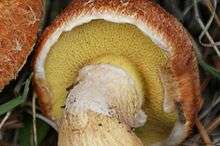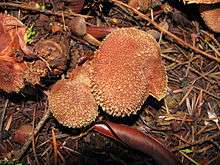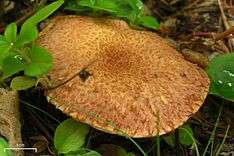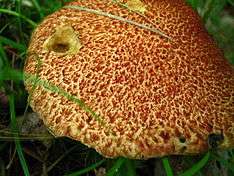Suillus lakei
Suillus lakei, commonly known as the matte Jack, Lake's bolete, or the western painted Suillus, is a species of fungus in the Suillaceae family. It is characterized by the distinctive reddish-brown tufted fibers or small scales on the cap, and the presence of a woolly veil on the stem. The caps can reach diameters of up to 15 cm (5.9 in), while the stems are between 6 to 12 cm (2.4 to 4.7 in) long and usually 1–3 cm (0.4–1.2 in) thick. On the underside of the cap is a layer of spongy yellow to yellow-brown angular pores; these pores are covered with a whitish partial veil when young. A mycorrhizal fungus, S. lakei grows in association with Douglas fir, and can be found where this tree occurs. It is native to northwestern North America, but has been introduced to Europe, South America, and New Zealand. The mushroom is edible, but opinions vary considerably as to its quality.
Taxonomy and naming
American mycologist William Alphonso Murrill originally named the species Boletinus lakei after mycologist E.R. Lake of Oregon Agricultural college (now Oregon State University). Lake collected the type specimen from Corvallis, Oregon, in late November, 1907.[1] Rolf Singer later transferred the species to the genera Ixocomus and Boletinus in 1940 and 1945, respectively.[2][3] In their 1964 monograph on North American Suillus species, Alexander H. Smith and Harry Delbert Thiers transferred the species to Suillus. Simultaneously, they described the S. lakei variety pseudopictus that they said had been misidentified by collectors as Suillus pictus (now called Suillus spraguei) because of its reddish and scaly cap.[4] Singer considered Suillus amabilis to be the same species as S. lakei, but Smith and Thiers later examined the type material of both, and concluded that they were distinct species.[5] Engel and colleagues described a variety in 1996, S. lakei var. landkammeri,[6] based on Boletinus tridentinus subsp. landkammeri described by Czech mycologists Albert Pilát and Mirko Svrček in 1949.[7] The nomenclatural databases Index Fungorum and MycoBank consider this synonymous with S. lakei.[8][9] The mushroom is commonly known as the "western painted Suillus",[10] the "matte Jack",[11] or "Lake's slippery cap".[12]
Description

The cap of S. lakei is up to 15 cm (5.9 in) in diameter and initially convex, but flattens out somewhat in maturity.[10] The cap is fleshy, dry, yellowish to reddish-brown but fades with age. It is covered with pressed-down hairs or minute tufted scales in the center, with the yellowish flesh visible between the scales. Heavy rain can wash the fibrils off the cap surface, leaving a sticky, glutinous layer behind. Older specimens may be nearly smooth in age. Remnants of the partial veil sometimes hang from the edge of the cap.[10] The cap margin is initially curved or rolled inwards, but unrolls as it grows and in maturity may be curled upward.[12]

The tubes that comprise the pore surface on the underside of the cap are 5–12 mm (0.2–0.5 in) deep; the angular pores are up to 2.5 mm wide and radially arranged.[13] The pores range in color from yellow to brownish-yellow to ochre, and stain brownish or reddish-brown when bruised. They are covered by a partial veil in young specimens.[10] The flesh is thick, yellow, and either unchanged in color when bruised or broken, or turns pinkish-red. The stem is 6 to 12 cm (2.4 to 4.7 in) long and usually 1–3 cm (0.4–1.2 in) thick, yellow sometimes with reddish streaks, and solid and yellow within. The species usually lacks the glandular dots on the stem that are characteristic of some Suillus species. The stem is either equal in width throughout its length, or tapered downwards. The tissue of the stem base may weakly stain bluish-green when cut, although this reaction is not usually apparent in mature specimens.[13] The ring is delicate and floccose (resembling woolly tufts), and soon disappears or leaves a thin whitish ring on the stem. The spore print is cinnamon to brown in color.[14] The variety calabrus, found in Italy, has a light yellow cap and purple-red scales.[15] Variety pseudopictus has a cap that is redder and more scaly than the more common form.[13]
The spores are spindle-shaped to elliptical, have a smooth surface, and dimensions of 8–11 to 3–4 µm.[10] There are both two- and four-spored basidia (spore-bearing cells), and they are club-shaped, hyaline (translucent), with dimensions of 28–36 by 10–12 µm. Cystidia are plentiful, and are found in bundles lined along the tube mouths (as cheilocystidia), or more commonly, singly along the sides of the tubes (as pleurocystidia). These structures are thin-walled, cylindrical, and measure 48–60 by 7–9 µm. The scales on the cap surface comprise more or less erect hyphae with tips that are clustered together. Clamp connections are rare in the hyphae.[4]
Edibility
Suillus lakei is edible,[16] although opinions vary considerably as to its quality. It has been called "choice",[17] as well as "rather coarse and tasteless"[18] or "mediocre".[19] Laboratory tests indicate the fruit bodies to have antimicrobial activity, and contain alkaloids and tannins.[20]
Similar species
Mushrooms with an appearance similar to S. lakei can often be distinguished by their associations with trees. For example, the eastern North American species S. spraguei grows in association with Eastern White Pine. The cap of S. spraguei has red fibrils on a yellow background. S. cavipes and S. ochraceoroseus always grow with Larch.[21] S. ponderosus, which grows in mixed coniferous forests, has a gelatinous veil.[12] Smith and Thiers note that it is difficult to tell the difference between the two if S. ponderosus has lost its veil, since the colors of the species intergrade and cannot reliably be used to distinguish them.[4] S. decipiens has a cap that is orangish to pink-orange with hairs or scales. S. caerulescens is a similar species in western North America; it can be distinguished by the strong blue staining that develops when the stem is injured.[21]
Habitat and distribution
Suillus lakei is indigenous to the Rocky Mountains and western parts of North America. Its range extends south into Mexico.[20] Fruit bodies grow solitarily or in groups on the ground in young conifer stands or grassy parkland. Fruiting occurs in the late summer and autumn. Suillus lakei forms ectomycorrhizae with Douglas fir (Pseudotsuga menziesii), and its distribution coincides with this tree. It is one of the most common bolete species found in northwestern Montana and Idaho.[21] In a study of host specificity in pure culture in the laboratory, S. lakei failed to form healthy ectomycorrhizas with Eucalyptus roots—the hyphae were covered in mucilage-like deposits and appeared to be collapsed.[22] It has also been noted to prefer poor, exposed soil such as that found on road banks and campgrounds.[10] It can often be found with the mushroom Gomphidius subroseus, another species that associates with Douglas fir.[18]
Both Douglas fir and Suillus lakei are non-native introduced species in Europe. The fungus has been found in several central and south European countries following the intentional introduction of Douglas fir.[23] These include Bosnia and Herzegovina, Bulgaria, Czech Republic,[24] Germany, Hungary,[25] Italy,[26] and Slovakia.[27] It is considered endangered in the Czech Republic.[28] Suillus lakei has also been reported in the South Island of New Zealand,[29] and South America (Argentina[30] and Chile[31]).
See also
References
- ↑ Murrill WA. (1912). "Polyporaceae and Boletaceae of the Pacific Coast". Mycologia. 4 (2): 91–100. doi:10.2307/3753546.
- ↑ Singer R. (1940). "Notes sur quelques Basidiomycètes" [Notes on some Basidiomycetes]. Revue de Mycologie (in French). 5: 3–13.
- ↑ Singer R. (1945). "The Boletineae of Florida with notes on extralimital species. II. The Boletaceae (Gyroporoideae)". Farlowia (2nd ed.). 2: 223–303.
- 1 2 3 Smith AH, Thiers HD (1964). A Contribution Toward a Monograph of North American Species of Suillus (Boletaceae). Ann Arbor, Michigan: Lubrecht & Cramer Ltd. pp. 34–6. ISBN 978-0-934454-26-1.
- ↑ Smith AH, Thiers HD (1967). "Comments on Suillus amabilis and Suillus lakei". Mycologia. 59 (2): 361–7. doi:10.2307/3756810.
- ↑ Engel H, Dermek A, Klofac W, Ludwig E, Brückner T (1996). Schmier- und Filzröhrlinge s.l. in Europa. Die Gattungen Boletellus, Boletinus, Phylloporus, Suillus, Xerocomus (in German). Weidhausen: H. Engel. ISBN 3-926470-08-9.
- ↑ Pilát A, Svrcek M (1949). "Boletinus tridentinus (Bres.) subsp. landkammeri spec. nov. bohemica". Acta Musei Nationalis Pragae (in Czech). 5B (7): 1–8.
- ↑ "Suillus lakei var. landkammeri (Pilát & Svrcek) H. Engel & Klofac 1996". MycoBank. International Mycological Association. Retrieved 2011-03-19.
- ↑ "Suillus lakei var. landkammeri (Pilát & Svrček) H. Engel & Klofac". Index Fungorum. CAB International. Retrieved 2011-09-21.
- 1 2 3 4 5 6 Arora D. (1986). Mushrooms Demystified: a Comprehensive Guide to the Fleshy Fungi. Berkeley, California: Ten Speed Press. p. 495. ISBN 0-89815-169-4.
- ↑ Arora D. (1991). All that the Rain Promises and More: a Hip Pocket Guide to Western Mushrooms. Berkeley, California: Ten Speed Press. p. 182. ISBN 0-89815-388-3.
- 1 2 3 McKnight VB, McKnight KH (1987). A Field Guide to Mushrooms, North America. Boston, Massachusetts: Houghton Mifflin. p. 116. ISBN 0-395-91090-0.
- 1 2 3 Bessette AE, Roody WC, Bessette AR (2000). Boletes of North America. Syracuse, New York: Syracuse University Press. pp. 242–3. ISBN 978-0-8156-0588-1.
- ↑ Kuo M. (December 2008). "Suillus lakei". MushroomExpert.com. Retrieved 2011-09-21.
- ↑ Lavorato C. (2000). "Suillus lakei var. calabrus var. nov". Micologia (in Italian): 285–8.
- ↑ Wood M, Stevens F. "Suillus lakei". California Fungi. MykoWeb. Retrieved 2009-09-18.
- ↑ Weber NS, Smith AH (1980). The Mushroom Hunter's Field Guide. Ann Arbor, Michigan: University of Michigan Press. pp. 94–5. ISBN 0-472-85610-3.
- 1 2 Evenson VS. (1997). Mushrooms of Colorado and the Southern Rocky Mountains. Westcliffe Publishers. p. 159. ISBN 978-1-56579-192-3.
- ↑ Kuo M. (2007). 100 Edible Mushrooms. Ann Arbor, Michigan: The University of Michigan Press. pp. 223–5. ISBN 0-472-03126-0.
- 1 2 Barranco PG, Ocanas LG, Cabrera LV, Carmona MCS, Ocanas FG, Gomez XSR, Rangel RL (2010). "Evaluation of antioxidant, immunomodulating, cytotoxic and antimicrobial properties of different strains of Basidiomycetes from Northeastern Mexico". Journal of Medicinal Plants Research. 4 (17): 1762–9. ISSN 1996-0875.
- 1 2 3 Miller HR, Miller OK (2006). North American Mushrooms: a Field Guide to Edible and Inedible Fungi. Guilford, Connecticut: Falcon Guide. p. 360. ISBN 0-7627-3109-5.
- ↑ Malajczuk N, Molina R, Trappe JM (1984). "Ectomycorrhiza formation in Eucalyptus .2. The ultrastructure of compatible and incompatible mycorrhizal fungi and associated roots". New Phytologist. 96 (1): 43–53. doi:10.1111/j.1469-8137.1984.tb03542.x. JSTOR 2432774.
- ↑ "Suillus lakei". Boletales.com. Retrieved 2010-11-12.
- ↑ Zahradka F. (2005). "Hrib douglaskovy - Boletinus lakei v okoli Dubnan u Hodonina" [Boletinus lakei around Dubnany in Hodonin]. Mykologicky Sbornik (in Czech). 82 (1): 28–9. ISSN 0374-9436.
- ↑ Vasas G, Albert L (1990). "Interesting fungi from Hungary. II. Basidiomycetes, Agaricales". Annales Historico-Naturales Musei Nationalis Hungarici (in Hungarian). 82: 61–4. ISSN 0521-4726.
- ↑ Lavorato C. (1999). "Suillus nordamericani presenti in Calabria" [North American Suillus present in Calabria]. Pagine di Micologia (in Italian) (12): 31–49.
- ↑ Assyov B, Stoichev G, Vassilev R (2006). "First records of fungus species for Bulgaria". Mycologia Balcanica (3): 127–30.
- ↑ Mikšik M. (2012). "Rare and protected species of boletes of the Czech Republic". Field Mycology. 13 (1): 8–16. doi:10.1016/j.fldmyc.2011.12.003.
- ↑ Myra C-C, Grace LJ (1986). "Mycorrhizal fungi of Pseudotsuga menziesii in the south island of New Zealand". Soil Biology and Biochemistry. 19 (3): 243–6. doi:10.1016/0038-0717(87)90004-6.
- ↑ Barroetaveña C, Cázares E, Rajchenberg M (2007). "Ectomycorrhizal fungi associated with ponderosa pine and Douglas-fir: a comparison of species richness in native western North American forests and Patagonian plantations from Argentina". Mycorrhiza. 17 (5): 355–73. doi:10.1007/s00572-007-0121-x. PMID 17345105.
- ↑ Valenzuela E, Esteve-Raventos F (1999). "Some allochthonous Agaricales s.l. associated with exotic trees cultivated in the X region of Chile". Boletin Micologico (in Spanish). 14 (1/2): 73–81. ISSN 0716-114X.

